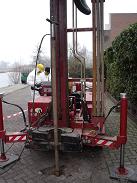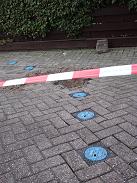With this project it is demonstrated how the direct push injection scheme of protamylasse can be designed.
Maximum concentrations during previous surveys:PCE: 817 μg/l; TCE: 4.885 μg/l; DCE (almost entirely Cis): 33.608 μg/l;VC: 4.867 μg/l. PCE, TCE and DCE have been found in low concentrations in soil at one sub location at a depth of 3,5 to 3,7 meters below surface.

 Left picture: direct push of protamylasse.
Right picture: monitoring wells (blue covers) at several depths and directions from the injection point.
Left picture: direct push of protamylasse.
Right picture: monitoring wells (blue covers) at several depths and directions from the injection point.Based on the monitoring results, recommendations have been given for the design of the injection scheme at this specific location:
- Start injecting at the basis of the borehole and continue in upward direction
- The matrix of injection points should be larger than the area to be treated
- Protamylasse migrates downward, based on the next phase of monitoring it may be decided to inject until a smaller depth but with smaller distance between injection points.
- Continue monitoring of potential migration of contaminants to deeper groundwater
- The contractor experimented with injection of compressed air with the aim to enhance injection of protamylasse. Results show that injection of compressed air does not improve the volume of substrate that can be injected of the radius of influence. Besides, based on the monitoring result (especially from the molecular analyses), the risk of adverse effects on VC-reducing bacteria could not be excluded. Therefore the advise is to assess both aspects further before continuing the practice of compressed air injection.
- Continue monitoring of nitrate and sulphate because of temporally high concentrations following injection of substrate.
Based on the results of this project, the following questions have been answered. How to design the injection scheme for protamylasse substrate in a heterogeneous soil? The contractor makes a design for the injection procedure based on experience. During a pilot or as first step in a remediation process, the design will be improved based on field measurements. Special measures to improve injection capacity can be tested in small scale experiments. This pilot phase will improve the full scale remediation and prevents damage and costs related to inefficient design or measures. How can the radius of influence of the substrate be assessed?At one monitoring well, pure protamylasse has been found. At other wells, information about the effect of the substrate injection have been acquired by monitoring of changes as a result of injection of substrate:
- Increasing EC
- Lowering of pH
- Increasing DOC concentration
- Increasing H2 concentration
- Decreasing nitrate and sulphate concentration (or temporal increase)
- Increasing concentration gene copies Dehalococcoides Spp. en VC-reductase enzymes
When interpreting changes in these single parameters, we have to deal with uncertainties. Therefore, it is important to consider the combination of parameters. The purpose of the substrate injections is to enable complete degradation of the CVOC-contaminants (at this site mainly DCE). Important parameters to assess the effect of the injection of protamylasse on degradation are DOC, hydrogen, redox conditions, nutrients and population of the required bacteria. Since protamylasse contains sulphate and nitrate in high concentrations, a temporal increase in those compounds may be observed in groundwater. The monitoring period should be long enough to assess whether temporal changes in the environment have come to a more stable situation. This will differ between locations. At the current site, the monitoring period of 6 months was not long enough but at other sites less time required. The radius of influence of the substrate will depend on the injection pattern. The injection pattern needs to be larger than the area to be treated. Due to the high density of protamylasse it will migrate downwards. In a moderately drained and very heterogeneous soil a high density of injection points is required (in this case about 2 meters), while the maximum depth of injection could be less than the maximum target depth.
Attached reports: indutch_reportpilotdirectpush
